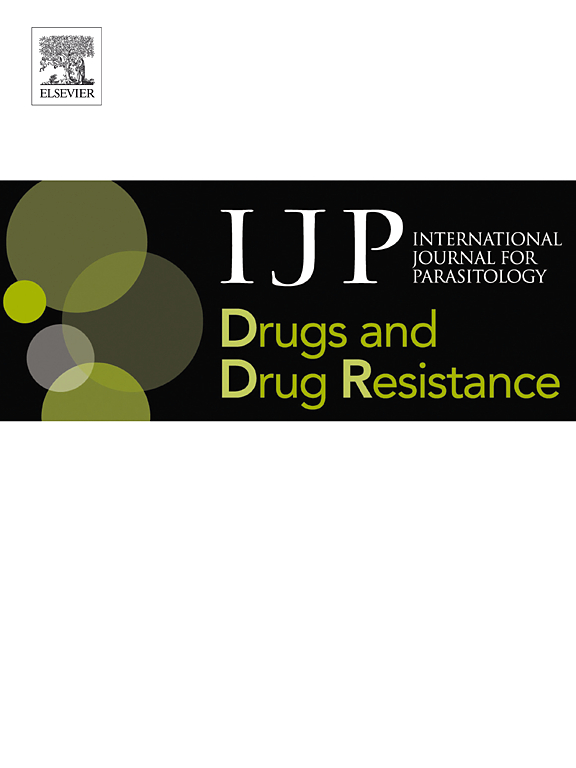Three Asparagine insertions in the K13-propeller led to Plasmodium falciparum becoming resistant to multiple antimalarial drugs
IF 3.4
2区 医学
Q1 PARASITOLOGY
International Journal for Parasitology: Drugs and Drug Resistance
Pub Date : 2025-04-25
DOI:10.1016/j.ijpddr.2025.100590
引用次数: 0
Abstract
Drug resistance in Plasmodium falciparum represents a significant challenge in malaria treatment. Identifying the molecular markers associated with P. falciparum resistance will effectively detect resistance and enhance treatment efficiency. In this study, we utilized the advanced CRISPR/Cas9 technology to precisely insert one, two, or three asparagine residues into the Kelch 13(K13) gene of the 3D7 strain, positioned after the 142nd amino acid residue, resulting in 1N-3D7, 2N-3D7, and 3N-3D7. Using ring-stage survival assays (RSA), drug sensitivity evaluations, and in vitro developmental assessments, our findings revealed a trend: 1) the insertion of asparagine residues into the parasite genome increased RSA, with more asparagine insertions leading to higher RSA. 2) According to the IC50 values, 1N-3D7 and 2N-3D7 exhibited similar sensitivity profiles across all ten tested drugs, with both demonstrating resistance to Naphthoquine, indicating that the insertions of one or two asparagines played an equivalent role in conferring resistance. However, the insertion of three asparagine residues resulted in significantly higher IC50 values compared to the first two forms when tested with Artesunate, Artemether, Dihydroartemisinin, Pyronaridine Phosphate, and Naphthoquine, showing resistance to all five drugs. Furthermore, 3N-3D7 exhibited a prolonged ring phase and a shortened trophozoite phase within red blood cells; the schizont phase appeared synchronous with the others, yet its mature schizonts contained fewer merozoites. Additionally, 3N-3D7 exhibited a fitness defect, with the proportion decreasing gradually during co-culture with 3D7, its fitness cost calculated as 14.88 ± 2.87. All these results support the opinion that the insertion of three asparagines was a molecular marker of resistance to artemisinin derivatives, Pyronaridine Phosphate, and Naphthoquine in P. falciparum.

在k13推进器中插入三个天冬酰胺导致恶性疟原虫对多种抗疟疾药物产生耐药性
恶性疟原虫的耐药性是疟疾治疗的一个重大挑战。鉴定恶性疟原虫耐药相关分子标记,将有效发现耐药性,提高治疗效率。在本研究中,我们利用先进的CRISPR/Cas9技术,在3D7菌株的Kelch 13(K13)基因中精确插入1、2或3个天冬酰胺残基,定位在第142个氨基酸残基之后,得到1N-3D7、2N-3D7和3N-3D7。通过环期生存试验(RSA)、药物敏感性评估和体外发育评估,我们的研究结果揭示了一个趋势:1)天冬酰胺残基插入寄生虫基因组增加了RSA,天冬酰胺插入越多,RSA越高。2)根据IC50值,1N-3D7和2N-3D7对10种被试药物的敏感性相似,均对萘醌产生耐药性,表明一种或两种天冬酰胺的插入对萘醌产生耐药性的作用相同。然而,当与青蒿琥酯、蒿甲醚、双氢青蒿素、磷酸吡啶和萘喹进行测试时,插入三种天冬酰胺残留物的IC50值明显高于前两种形式,显示出对所有五种药物的耐药性。3N-3D7红细胞内环期延长,滋养体期缩短;分裂体阶段与其他阶段同步,但其成熟分裂体含有较少的分裂子。3N-3D7存在适合度缺陷,在与3D7共培养过程中比例逐渐降低,其适合度成本计算为14.88±2.87。这些结果支持了3个天冬酰胺的插入是恶性疟原虫对青蒿素衍生物、磷酸吡啶和萘喹耐药的分子标记。
本文章由计算机程序翻译,如有差异,请以英文原文为准。
求助全文
约1分钟内获得全文
求助全文
来源期刊

International Journal for Parasitology: Drugs and Drug Resistance
PARASITOLOGY-PHARMACOLOGY & PHARMACY
CiteScore
7.90
自引率
7.50%
发文量
31
审稿时长
48 days
期刊介绍:
The International Journal for Parasitology – Drugs and Drug Resistance is one of a series of specialist, open access journals launched by the International Journal for Parasitology. It publishes the results of original research in the area of anti-parasite drug identification, development and evaluation, and parasite drug resistance. The journal also covers research into natural products as anti-parasitic agents, and bioactive parasite products. Studies can be aimed at unicellular or multicellular parasites of human or veterinary importance.
 求助内容:
求助内容: 应助结果提醒方式:
应助结果提醒方式:


